Effects of Competition on the Vertical Distribution of Foliage Biomass within the Crowns of Planted Korean Pine Trees in Northeast China
Abstract
1. Introduction
2. Materials and Methods
2.1. Study Area
2.2. Sample Plot Establishment and Sample Tree Selection
2.3. Branch Analysis and Foliage Biomass Calculation
2.4. Foliage Biomass Distribution Model Development
3. Results
3.1. Foliage Biomass Distribution at the Branch Level
3.2. Foliage Biomass Distribution at the Annual Shoot Level
4. Discussion
5. Conclusions
Author Contributions
Funding
Data Availability Statement
Acknowledgments
Conflicts of Interest
References
- Porté, A.; Bosc, A.; Champion, I.; Loustau, D. Estimating the foliage area of Maritime pine (Pinus pinaster Aït.) branches and crowns with application to modelling the foliage area distribution in the crown. Ann. For. Sci. 2000, 57, 73–86. [Google Scholar] [CrossRef]
- Han, Q.; Kabeya, D.; Saito, S.; Araki, M.G.; Kawasaki, T.; Migita, C.; Chiba, Y. Thinning alters crown dynamics and biomass increment within aboveground tissues in young stand of Chamaecyparis obtusa. J. For. Res. 2014, 19, 184–193. [Google Scholar] [CrossRef]
- Forrester, D.I.; Medhurst, J.L.; Wood, M.; Beadle, C.L.; Valencia, J.C. Growth and physiological responses to silviculture for producing solid-wood products from Eucalyptus plantations: An Australian perspective. For. Ecol. Manag. 2010, 259, 1819–1835. [Google Scholar] [CrossRef]
- Horn, H.S. The Adaptive Geometry of Trees; Princeton University Press: Princeton, NJ, USA, 1971. [Google Scholar]
- Tahvanainen, T.; Forss, E. Individual tree models for the crown biomass distribution of Scots pine, Norway spruce and birch in Finland. For. Ecol. Manag. 2008, 255, 455–467. [Google Scholar] [CrossRef]
- Uria-Diez, J.; Pommerening, A. Crown plasticity in Scots pine (Pinus sylvestris L.) as a strategy of adaptation to competition and environmental factors. Ecol. Model. 2017, 356, 117–126. [Google Scholar] [CrossRef]
- DeRose, R.; Seymour, R.S. Patterns of leaf area index during stand development in even-aged balsam fir-red spruce stands. Can. J. For. Res. 2010, 40, 629–637. [Google Scholar] [CrossRef]
- Weiskittel, A.R.; Kershaw, J.A., Jr.; Hofmeyer, P.V.; Seymour, R.S. Species differences in total and vertical distribution of branch- and tree-level leaf area for the five primary conifer species in Maine, USA. For. Ecol. Manag. 2009, 258, 1695–1703. [Google Scholar] [CrossRef]
- Lintunen, A.; Sievänen, R.; Kaitaniemi, P.; Perttunen, J. Models of 3D crown structure for Scots pine (Pinus sylvestris) and silver birch (Betula pendula) grown in mixed forest. Can. J. For. Res. 2011, 41, 1779–1794. [Google Scholar] [CrossRef]
- Ford, E.D. The dynamic relationship between plant architecture and competition. Front. Plant Sci. 2014, 5, 275. [Google Scholar] [CrossRef]
- Power, H.; Schneider, R.; Berninger, F. Understanding changes in black (Picea marina) and white spruce (Picea glauca) foliage biomass and leaf area characteristics. Trees 2014, 28, 345–357. [Google Scholar] [CrossRef]
- Goudie, G.W.; Parish, R.; Antos, J.A. Foliage biomass and specific leaf area equations at the branch, annual shoot and whole-tree levels for lodgepole pine and white spruce in British Columbia. For. Ecol. Manag. 2016, 361, 286–297. [Google Scholar] [CrossRef]
- Schneider, R.; Fortin, M.; Ung, C.H.; Swift, D.E.; Zhang, S.Y. Modeling Jack Pine (Pinus banksiana) foliage density distribution. For. Sci. 2011, 57, 180–188. [Google Scholar]
- Shinozaki, K.; Yoda, K.; Hozumi, K.; Kira, T. A quantitative analysis of plant form: The pipe model theory. I. Basic analyses. Jpn. J. Ecol. 1964, 14, 97–105. [Google Scholar]
- Wang, Y.P.; Jarvis, P.G. Influence of shoot structure on the photosynthesis of Sitka spruce (Picea sitchensis). Funct. Ecol. 1993, 7, 433–451. [Google Scholar] [CrossRef]
- Baldwin, V.C., Jr.; Peterson, K.D.; Burkhart, H.E.; Amateis, R.L.; Dougherty, P.M. Equations for estimating loblolly pine branch and foliage weight and surface area distributions. Can. J. For. Res. 1997, 27, 918–927. [Google Scholar] [CrossRef]
- Santos, V.A.H.F.; Ferreira, M.J. Are photosynthetic leaf traits related to the first-year growth of tropical tree seedlings? A light-induced plasticity test in a secondary forest enrichment planting. For. Ecol. Manag. 2020, 460, 117900. [Google Scholar] [CrossRef]
- Albaugh, T.J.; Maier, C.A.; Campoe, O.C.; Yáñez, M.A.; Carbaugh, E.D.; Carter, D.R.; Cook, R.L.; Rubilar, R.A.; Fox, T.R. Crown architecture, crown leaf area distribution, and individual tree growth efficiency vary across site, genetic entry, and planting density. Trees 2020, 34, 73–88. [Google Scholar] [CrossRef]
- Brinkhoff, R.; Mendham, D.; Hunt, M.; Unwin, G.; Hovenden, M. Nitrogen fertiliser only increases leaf area in the lower crown of mid-rotation Eucalyptus nitens plantations. For. Ecol. Manag. 2022, 508, 120048. [Google Scholar] [CrossRef]
- Adji, B.I.; Akaffou, D.S.; Kouassi, K.H.; Houphouet, Y.P.; Reffye, P.D.; Duminil, J.; Jaeger, M.; Sabatier, S. Allometric models for non-destructive estimation of dry biomass and leaf area in Khaya senegalensis (Desr.) A. Juss., 1830 (Meliaceae), Pterocarpus erinaceus Poir., 1804 (Fabaceae) and Parkia biglobosa, Jack, R. Br., 1830 (Fabaceae). Trees 2021, 35, 1905–1920. [Google Scholar] [CrossRef]
- Lin, S.; Niklas, K.J.; Wan, Y.; Holscher, D.; Hui, C.; Ding, Y.; Shi, P. Leaf shape influences the scaling of leaf dry mass vs. area: A test case using bamboos. Ann. For. Sci. 2020, 77, 11. [Google Scholar] [CrossRef]
- Weiskittel, A.R.; Temesgen, H.; Wilson, D.S.; Maguire, D.A. Sources of within and between-stand variability in specific leaf area of three ecologically distinct conifer species. Ann. For. Sci. 2020, 65, 103. [Google Scholar] [CrossRef]
- Xu, M.; Harrington, T.B. Foliage biomass distribution of loblolly pine as affected by tree dominance, crown size, and stand characteristics. Can. J. For. Res. 1998, 28, 887–892. [Google Scholar] [CrossRef]
- Longuetaud, F.; Seifert, T.; Leban, J.-M.; Pretzsch, H. Analysis of long-term dynamics of crowns of sessile oaks at the stand level by means of spatial statistics. For. Ecol. Manag. 2008, 255, 2007–2019. [Google Scholar] [CrossRef]
- Mäkelä, A.; Valentine, H.T. Crown ratio influences allometric scaling in trees. Ecology 2006, 87, 2967–2972. [Google Scholar] [CrossRef]
- Pretzsch, H. Tree growth as affected by stem and crown structure. Trees 2021, 35, 947–960. [Google Scholar] [CrossRef]
- Antos, J.A.; Parish, R.; Nigh, G.D. Effects of neighbours on crown length of Abies lasiocarpa and Picea engelmannii in two old growth stands in British Columbia. Can. J. For. Res. 2020, 40, 638–647. [Google Scholar] [CrossRef]
- Seleznyova, A.N.; Greer, D.H. Effects of temperature and leaf position on leaf area expansion of Kiwifruit (Actinidia deliciosa) shoots: Development of a modeling framework. Ann. Bot. 2001, 88, 605–615. [Google Scholar] [CrossRef]
- Brisson, J. Neighborhood competition and crown asymmetry in Acer saccharum. Can. J. For. Res. 2001, 31, 2151–2159. [Google Scholar] [CrossRef]
- Schneider, R.; Berninger, F.; Ung, C.H.; Mäkelä, A.; Swift, D.E.; Zhang, S.Y. Within crown variation in the relationship between foliage biomass and sapwood area in Jack pine. Tree Physiol. 2011, 31, 22–29. [Google Scholar] [CrossRef]
- Linnell Nemec, A.F.; Parish, R.; Goudie, J.W. Modelling number, vertical distribution, and size of live branches on coniferous tree species in British Columbia. Can. J. For. Res. 2012, 42, 1072–1090. [Google Scholar] [CrossRef]
- Gao, H.L.; Bi, H.Q.; Li, F.R. Modelling conifer crown profiles as nonlinear conditional quantiles: An example with planted Korean pine in northeast China. For. Ecol. Manag. 2017, 398, 101–115. [Google Scholar] [CrossRef]
- Piao, Z.; Tang, L.; Swihart, R.K.; Wang, S. Human–wildlife competition for Korean pine seeds: Vertebrate responses and implications for mixed forests on Changbai Mountain, China. Ann. For. Sci. 2011, 68, 911–919. [Google Scholar] [CrossRef]
- Schabenberger, O.; Pierce, F.J. Contemporary Statistical Models for the Plant and Soil Sciences; CRC Press: Boca Raton, FL, USA, 2002; 738p. [Google Scholar]
- Wang, Y.P.; Jarvis, P.G.; Benson, M.L. Two-dimensional needle-area density distribution within the crowns of Pinus radiata. For. Ecol. Manag. 1990, 32, 217–237. [Google Scholar] [CrossRef]
- Sun, Y.X.; Feng, J.; Chen, D.S.; Gao, H.L.; Zou, H.T. Developing crown shape model considering a novel competition index—A case for Korean pine plantation in northeast China. Can. J. For. Res. 2022, 52, 1128–1139. [Google Scholar] [CrossRef]
- Ledermann, T. A non-linear model to predict crown recession of Norway spruce (Picea abies [L.] Karst.) in Austria. Eur. J. For. Res. 2011, 130, 521–531. [Google Scholar] [CrossRef]
- Kahriman, A.; Şahin, A.; Sönmez, T.; Yavuz, M. A novel approach to selecting a competition index: The effect of competition on individual tree diameter growth of Calabrian pine. Can. J. For. Res. 2018, 48, 1217–1226. [Google Scholar] [CrossRef]
- Pinheiro, J.C.; Bates, D.M. Mixed-Effects Models in S and S-Plus; Springer: New York, NY, USA, 2000. [Google Scholar]
- Pinheiro, J.; Bates, D.; DebRoy, S.; Sarkar, D. nlme: Linear and Nonlinear Mixed Effects Models. R Package Version 3.1-160. 2000. Available online: http://CRAN.R-project.org/package=nlme (accessed on 10 October 2022).
- R Core Team. R: A Language and Environment for Statistical Computing; R Foundation for Statistical Computing: Vienna, Austria, 2019; Available online: https://www.R-project.org/ (accessed on 15 November 2019).
- Rayachhetry, M.B.; Van, T.K.; Center, T.D.; Laroche, F. Dry weight estimation of the aboveground components of Melaleuca quinquenervia trees in southern Florida. For. Ecol. Manag. 2001, 142, 281–290. [Google Scholar] [CrossRef]
- Xiao, C.W.; Ceulemans, R. Allometric relationships for below- and aboveground biomass of young Scots pines. For. Ecol. Manag. 2004, 203, 177–186. [Google Scholar] [CrossRef]
- Stenberg, P.; Kuuluvainen, T.; Kellomaki, S.; Grace, J.; Jokela, E.J.; Gholz, H.L. Crown structure, light interception and productivity of pine trees and stands. Ecol. Bull. 1994, 43, 20–34. [Google Scholar]
- Ishii, H.; Wilson, M.E. Crown structure of old-growth Douglas-fir in the western Cascade range, Washington. Can. J. For. Res. 2001, 31, 1250–1261. [Google Scholar] [CrossRef]
- Maguire, D.A.; Bennett, W.S. Patterns in vertical distribution of foliage in young coastal Douglas-fir. Can. J. For. Res. 1996, 26, 1991–2005. [Google Scholar] [CrossRef]
- Sternberg, M.; Shoshany, M. Aboveground biomass allocation and water content relationships in Mediterranean trees and shrubs in two climatological regions in Israel. Plant Ecol. 2001, 157, 171–179. [Google Scholar] [CrossRef]
- Mäkelä, A.; Vanninen, P. Vertical structure of Scots pine crowns in different age and size classes. Trees 2001, 15, 385–392. [Google Scholar] [CrossRef]
- Leroy, C.; Saint-Andre, L.; Auclair, D. Practical methods for nondestructive measurement of tree leaf area. Agrofor. Syst. 2007, 71, 99–108. [Google Scholar] [CrossRef]
- Fourcaud, T.; Zhang, X.P.; Stokes, A.; Lambers, H.; Koerner, C. Plant growth modelling and applications: The increasing importance of plant architecture in growth models. Ann. Bot. 2008, 101, 1053–1063. [Google Scholar] [CrossRef]
- Bascietto, M.; De Cinti, B.; Matteucci, G.; Cescatti, A. Biometric assessment of aboveground carbon pools and fluxes in three European forests by randomized branch sampling. For. Ecol. Manag. 2012, 267, 172–181. [Google Scholar] [CrossRef]
- Helmisaari, H.S.; Makkonen, K.; Kellomäki, S.; Valtonen, E.; Mälkönen, E. Below- and above-ground biomass, production and nitrogen use in Scots pine stands in eastern Finland. For. Ecol. Manag. 2002, 165, 317–326. [Google Scholar] [CrossRef]
- Garber, S.M.; Maguire, D.A. The response of vertical foliage distribution to spacing and species composition in mixed conifer stands in central Oregon. For. Ecol. Manag. 2005, 211, 341–355. [Google Scholar] [CrossRef]
- Gspaltl, M.; Bauerle, W.; Binkley, D.; Sterba, H. Leaf area and light use efficiency patterns of Norway spruce under different thinning regimes and age classes. For. Ecol. Manag. 2011, 288, 49–59. [Google Scholar] [CrossRef]
- Yu, M.H.; Canham, C.D.; Peters, C.M. A neighborhood analysis: Effects of crowding on tree growth in a single-tree selectively logged forest. In Proceedings of the 94th ESA Annual Convention 2009, Albuqerque, NM, USA, 2–7 August 2009. [Google Scholar]
- Marshall, J.D.; Monserud, R.A. Foliage height influences specific leaf area of three conifer species. Can. J. For. Res. 2003, 33, 164–170. [Google Scholar] [CrossRef]
- Duursma, R.A.; Mäkelä, A.; Reid, D.E.B.; Jokela, E.J.; Portcb, A.J.; Roberts, S.D. Self-shading affects allometric scaling in trees. Funct. Ecol. 2010, 24, 723–730. [Google Scholar] [CrossRef]
- Meng, S.X.; Rudnicki, M.; Lieffers, V.J.; Reid, D.E.B.; Silins, U. Preventing crown collisions increases the crown cover and leaf area of maturing lodgepole pine. J. Ecol. 2006, 94, 681–686. [Google Scholar] [CrossRef]
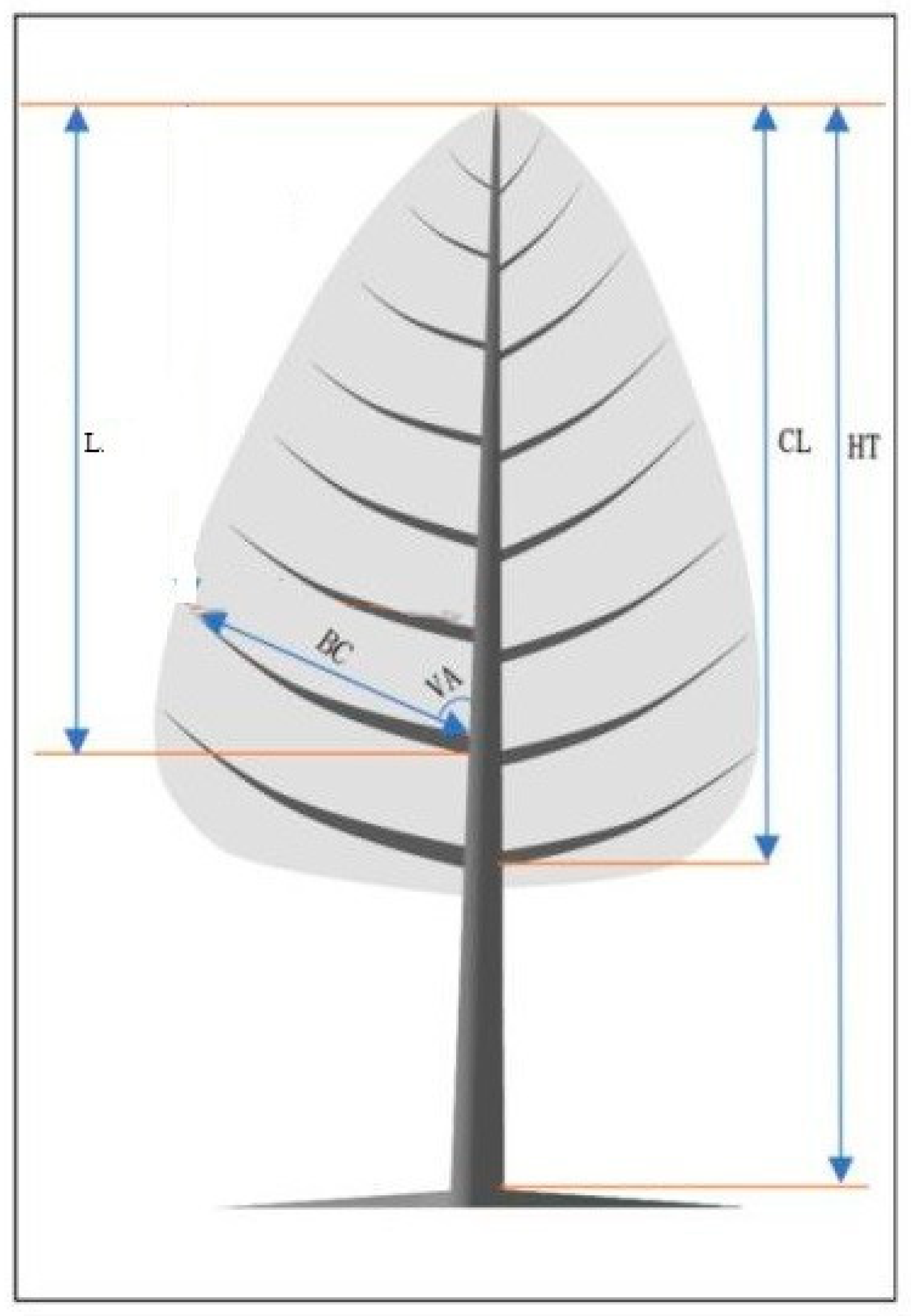
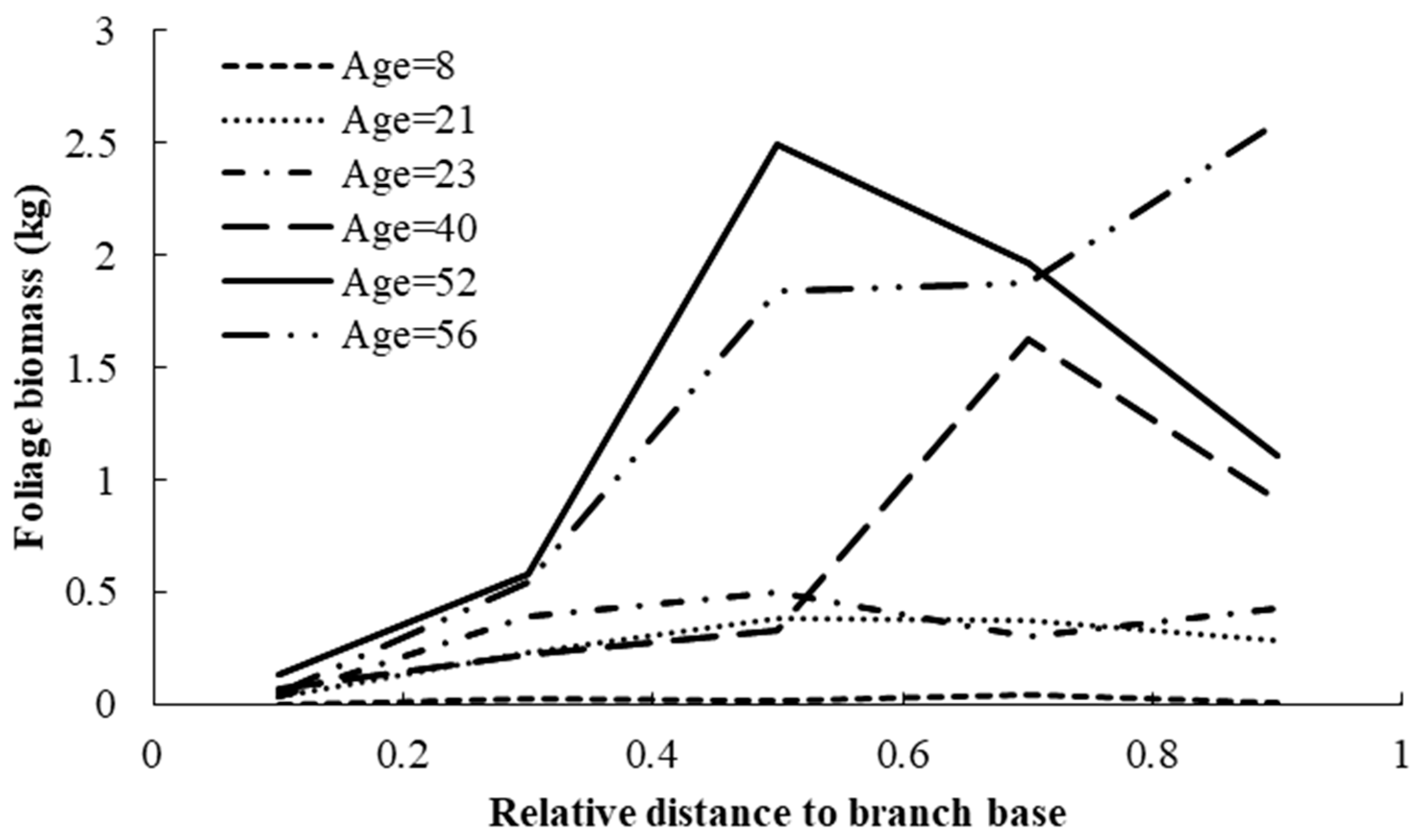
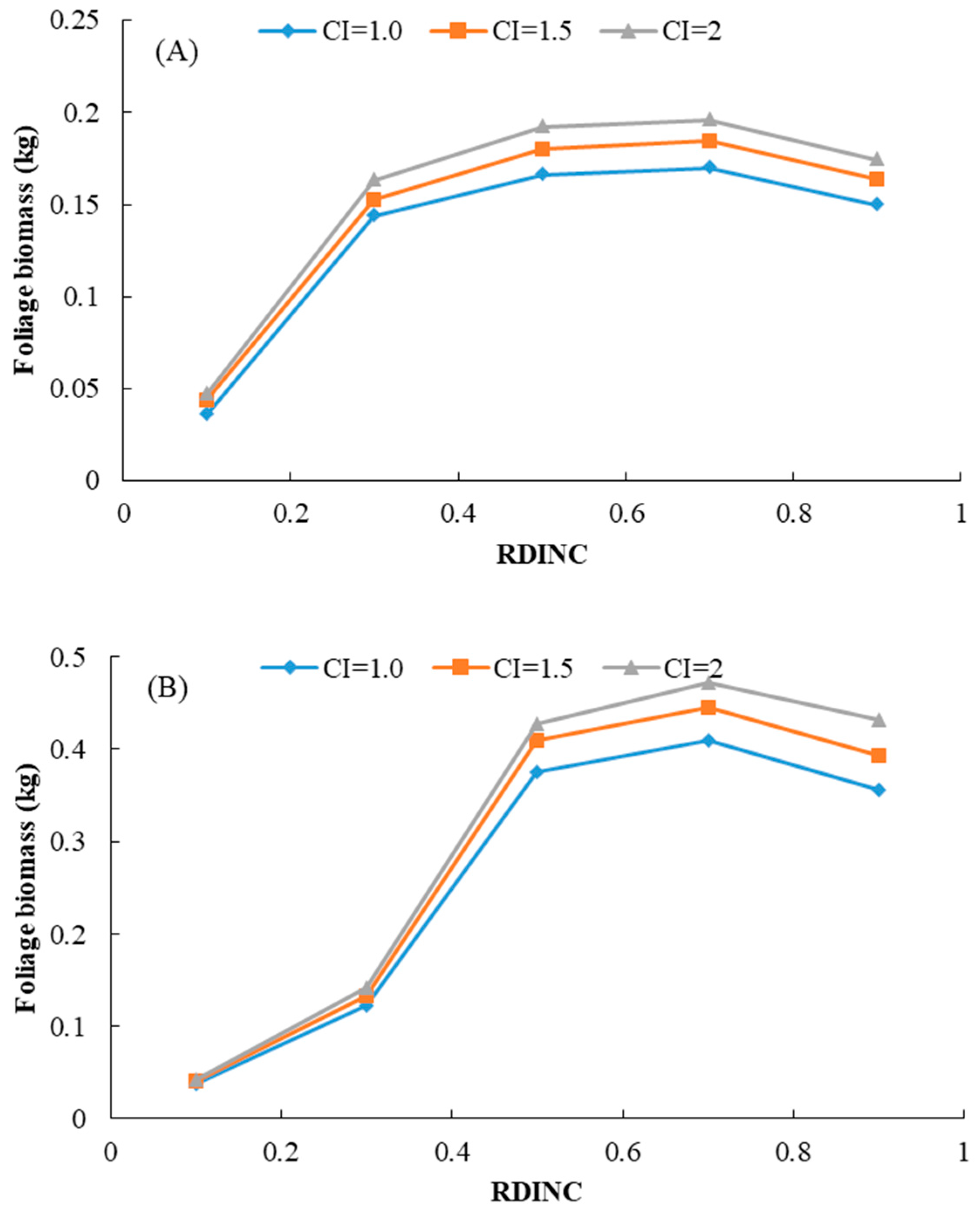
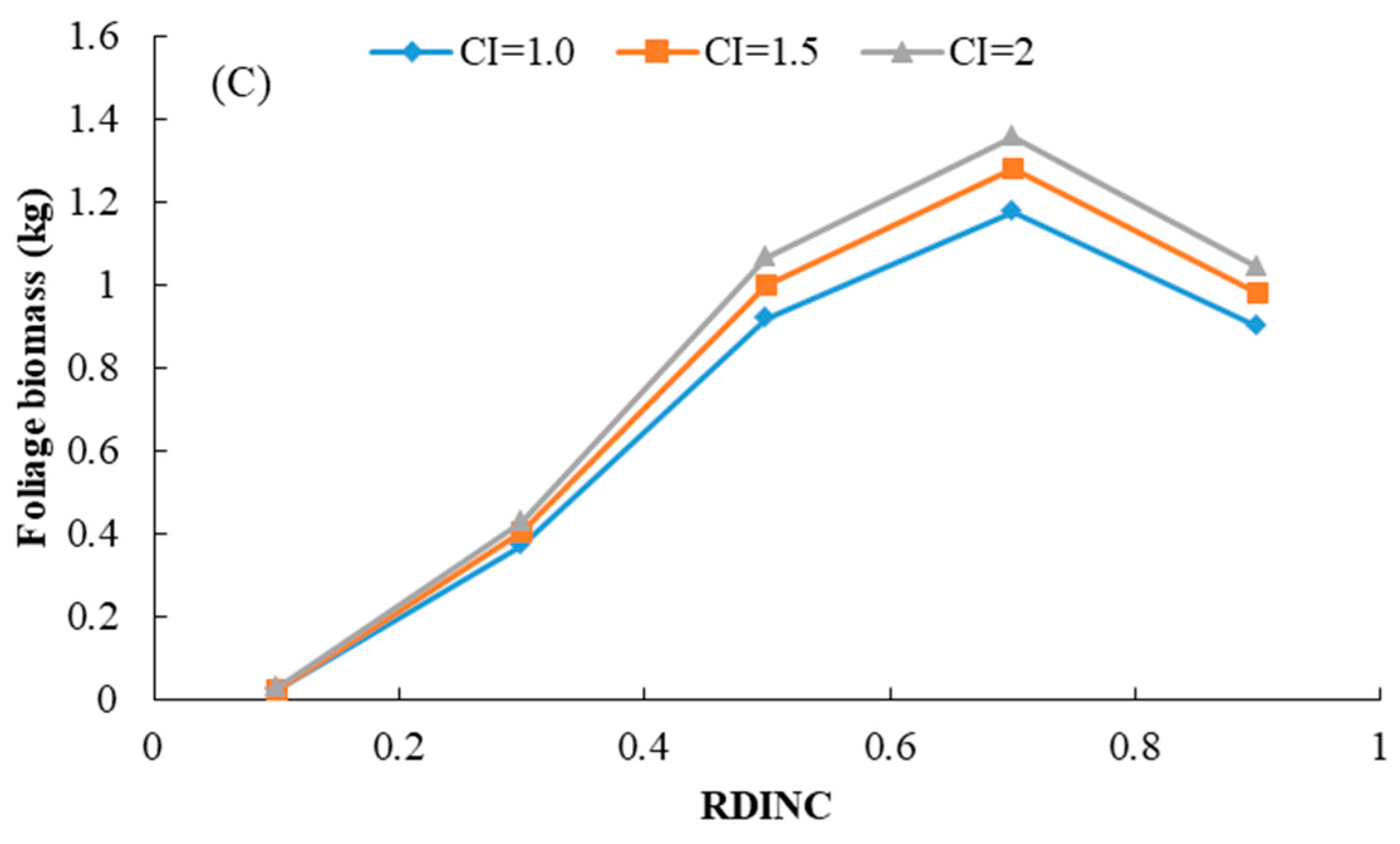
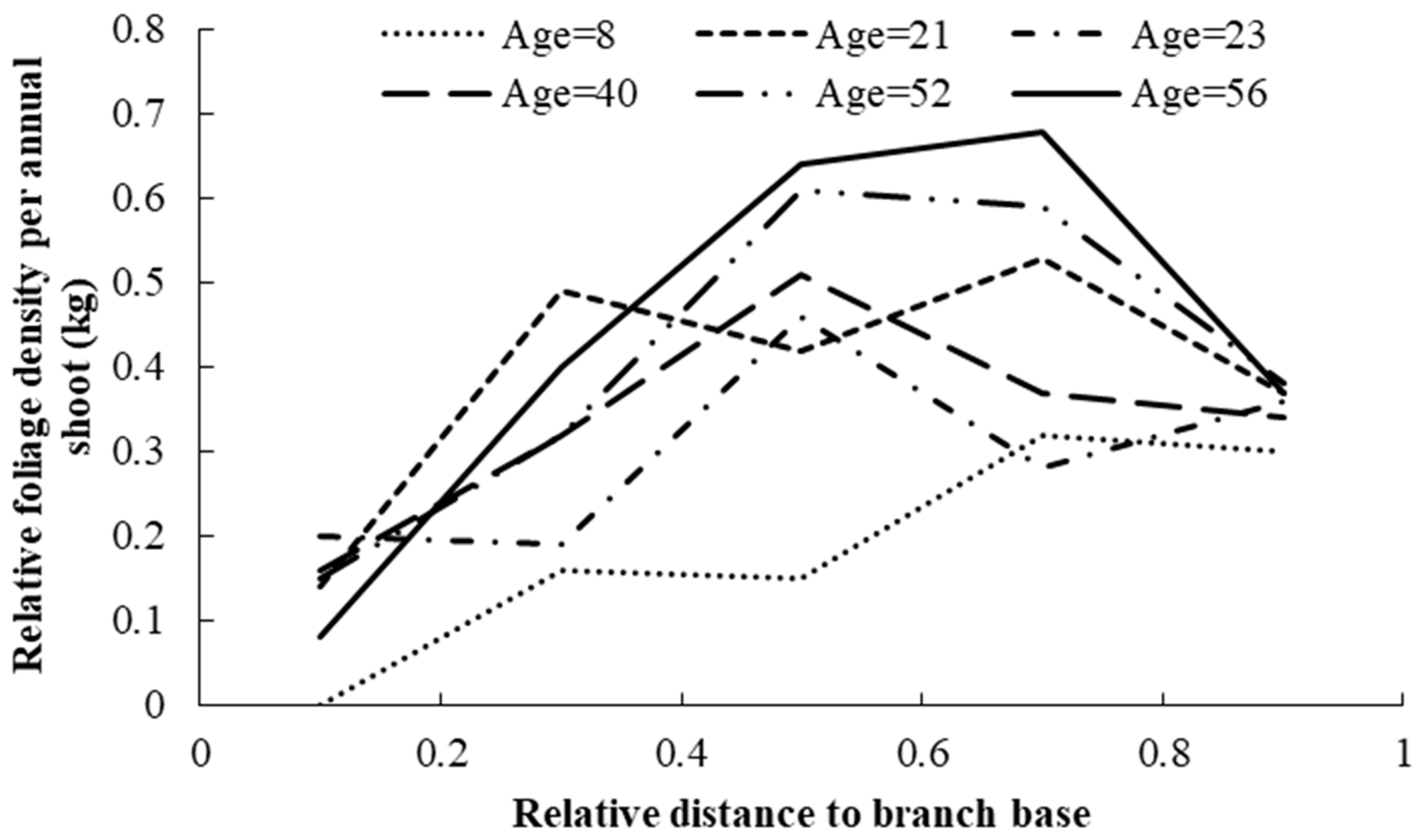
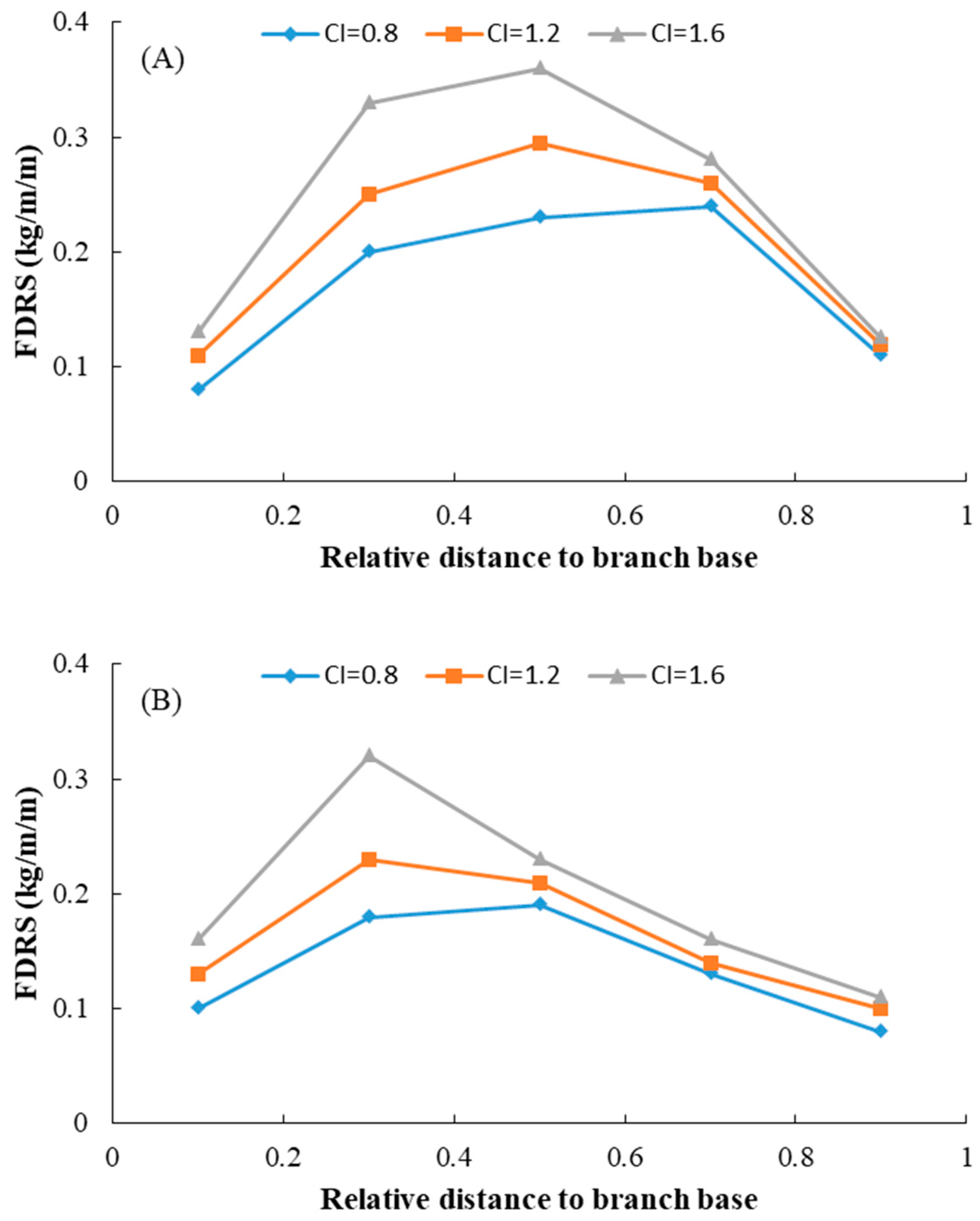
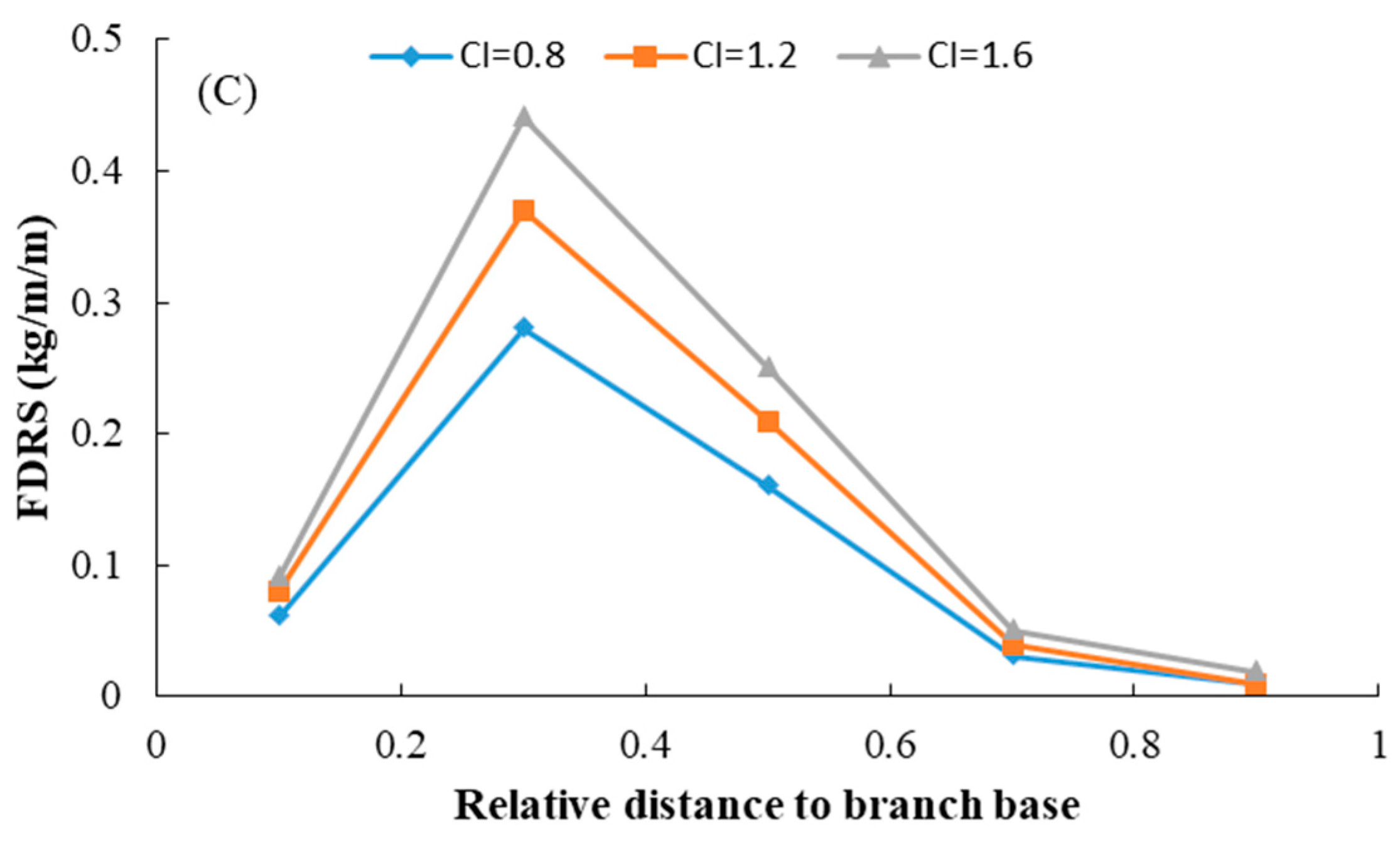
| Location | Stand Age (Year) | Ns | Nt | Dg (cm) | Hdom (m) | Density (Trees ha−1) | CW (m) |
|---|---|---|---|---|---|---|---|
| DBG | 8 | 3 | 9 | 1.8 | 2.2 | 1917 | 0.55 |
| 21 | 3 | 9 | 13.8 | 11.4 | 1806 | 1.71 | |
| 23 | 3 | 9 | 12.9 | 11.5 | 1256 | 1.62 | |
| 40 | 3 | 9 | 23.6 | 16.8 | 700 | 2.21 | |
| 52 | 3 | 9 | 31.7 | 20.7 | 322 | 3.11 | |
| 56 | 1 | 3 | 35.1 | 21.0 | 233 | 3.68 | |
| BSJ | 43 | 1 | 3 | 25.3 | 16.2 | 680 | 2.99 |
| Tree Class | Statistics | Age (Year) | DBH (cm) | HT (m) | HD | CR |
|---|---|---|---|---|---|---|
| Dominant tree | Mean ± Std | 34 ± 15 | 24.7 ± 11.7 | 12.8 ± 5.6 | 0.56 ± 0.11 | 0.69 ± 0.18 |
| Min. | 8 | 3.5 | 2.5 | 0.45 | 0.46 | |
| Max. | 56 | 43.1 | 20.2 | 0.84 | 1.02 | |
| Intermediate tree | Mean ± Std | 33 ± 16 | 19.4 ± 10.9 | 11.8 ± 5.8 | 0.68 ± 0.17 | 0.69 ± 0.15 |
| Min | 8 | 2.0 | 2.1 | 0.50 | 0.44 | |
| Max | 56 | 36.1 | 19.7 | 1.05 | 1.04 | |
| Suppressed tree | Mean ± Std | 33 ± 16 | 14.9 ± 9.1 | 10.7 ± 5.7 | 0.89 ± 0.36 | 0.65 ± 0.15 |
| Min | 8 | 1.1 | 1.8 | 0.59 | 0.41 | |
| Max | 56 | 29.5 | 18.6 | 1.81 | 0.93 |
| Symbol | Definition | Measure |
|---|---|---|
| Branch level | ||
| LBR | Branch length | The length of a natural stretch from bole pith to branch tip |
| BC | Branch chord length | The length between the bole pith and branch tip |
| ABR | Branch age | Ring numbers at the branch base |
| HRCC | Relative distance to crown contact | Ratio of distance between HT and branch base height to the distance between HT and crown contact height to the neighboring trees |
| LR1 | Relative distance down an annual shoot | Distance from the leader to the midpoint of the annual shoot divided by the distance between base of leader and height to base node |
| FDRs | Relative annual shoot foliage density | Ratio of annual shoot foliage density to the top of the first annual shoot below the live crown void of live branches |
| Tree level | ||
| DBH | Diameter at the breast height | |
| CR | Crown ratio | Ratio of crown length and total tree height |
| HT | Tree height | |
| FB | Foliage biomass | Foliage biomass for the specific branch |
| Competition | ||
| CI1 | Competition index 1 | Ratio of the diameter of the subject tree to the quadratic mean diameter |
| CI2 | Competition index 2 | Ratio of the basal area of the subject tree to the mean basal area of the stand |
| CI3 | Competition index 3 | Sum of the basal areas of those trees with a diameter greater than that of the subject tree |
| CI4 | Competition index 4 | Relating the stand density to the crown base of the subject tree and combines the horizontal and vertical competition effects |
| Tree Status | Attributes | Mean | Std | Min. | Max. |
|---|---|---|---|---|---|
| Dominant tree | Foliage biomass per branch (g) | 282.9 | 452.2 | 0.2 | 3861.3 |
| Branch diameter (BD, mm) | 28.07 | 18.83 | 2.28 | 96.95 | |
| Branch length (BL, cm) | 215.4 | 163.9 | 1.0 | 760.0 | |
| Branch chord length (BC, mm) | 196.2 | 148.5 | 1.0 | 692.0 | |
| branch angle (VA, °) | 42 | 18 | 3 | 135 | |
| Intermediate tree | Foliage biomass per branch (g) | 285.5 | 612.1 | 0.1 | 3670.1 |
| Branch diameter (BD, mm) | 22.95 | 14.90 | 2.17 | 77.01 | |
| Branch length (BL, cm) | 174.5 | 131.4 | 1.0 | 637.0 | |
| Branch chord length (BC, mm) | 161.5 | 121.4 | 1.0 | 601.0 | |
| branch angle (VA, °) | 37 | 17 | 5 | 130 | |
| Suppressed tree | Foliage biomass per branch (g) | 137.1 | 239.4 | 0.1 | 2122.9 |
| Branch diameter (BD, mm) | 17.50 | 12.20 | 1.36 | 69.00 | |
| Branch length (BL, cm) | 140.0 | 116.4 | 1.0 | 682 | |
| Branch chord length (BC, mm) | 130.2 | 107.9 | 1.0 | 625 | |
| branch angle (VA,°) | 43 | 20 | 5 | 150 |
| Model | Random Effects | Variance Function | AIC | −2loglikelihood | RMSE | Ra2 |
|---|---|---|---|---|---|---|
| Equation (7) | u4 | = 0.0312 | 4465 | 4450 | 283.8 | 0.44 |
| Equation (8) | u2 | = 0.0151 | 393 | −371.4 | 0.31 | 0.28 |
| Equation (7) | Equation (8) | ||||||
|---|---|---|---|---|---|---|---|
| Parameter | Estimate | Std | p | Parameter | Estimate | Std | p |
| a0 | 0.2096 | 0.0605 | 0.0006 | b0 | 0.8459 | 0.0580 | <0.0001 |
| a1 | 2.0471 | 0.0712 | <0.0001 | b1 | 0.6439 | 0.0918 | <0.0001 |
| a2 | 0.2110 | 0.0873 | 0.0158 | b2 | 1.6539 | 0.1006 | <0.0001 |
| b3 | 5.6105 | 0.3341 | <0.0001 | ||||
Disclaimer/Publisher’s Note: The statements, opinions and data contained in all publications are solely those of the individual author(s) and contributor(s) and not of MDPI and/or the editor(s). MDPI and/or the editor(s) disclaim responsibility for any injury to people or property resulting from any ideas, methods, instructions or products referred to in the content. |
© 2023 by the authors. Licensee MDPI, Basel, Switzerland. This article is an open access article distributed under the terms and conditions of the Creative Commons Attribution (CC BY) license (https://creativecommons.org/licenses/by/4.0/).
Share and Cite
Gao, H.; Feng, J.; Chen, D.; Hou, Y.; Sun, Y.; Dong, G. Effects of Competition on the Vertical Distribution of Foliage Biomass within the Crowns of Planted Korean Pine Trees in Northeast China. Forests 2023, 14, 1005. https://doi.org/10.3390/f14051005
Gao H, Feng J, Chen D, Hou Y, Sun Y, Dong G. Effects of Competition on the Vertical Distribution of Foliage Biomass within the Crowns of Planted Korean Pine Trees in Northeast China. Forests. 2023; 14(5):1005. https://doi.org/10.3390/f14051005
Chicago/Turabian StyleGao, Huilin, Jian Feng, Dongsheng Chen, Yimei Hou, Yunxia Sun, and Guijun Dong. 2023. "Effects of Competition on the Vertical Distribution of Foliage Biomass within the Crowns of Planted Korean Pine Trees in Northeast China" Forests 14, no. 5: 1005. https://doi.org/10.3390/f14051005
APA StyleGao, H., Feng, J., Chen, D., Hou, Y., Sun, Y., & Dong, G. (2023). Effects of Competition on the Vertical Distribution of Foliage Biomass within the Crowns of Planted Korean Pine Trees in Northeast China. Forests, 14(5), 1005. https://doi.org/10.3390/f14051005





